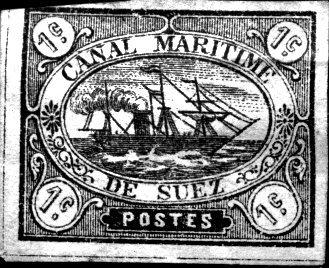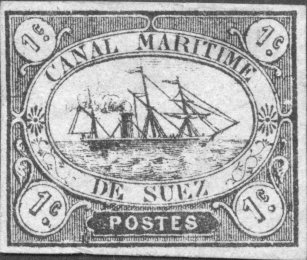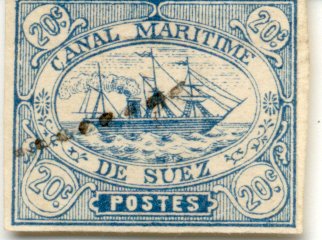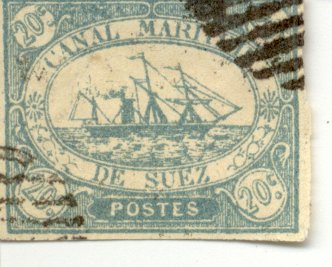THE POSTAGE STAMPS OF THE
SUEZ CANAL COMPANY
This page summarizes all the information that I have on these issues; it has been extracted
from the following sources:
- "The Robson Lowe Encyclopaedia of British Empire Stamps" (1949 ed.)
- "Forgery & Reprint Guide 14: SUEZ CANAL COMPANY" J. Barefoot Ltd. 1983
- "SUEZ CANAL STAMPS: CHARACTERISTICS OF GENUINE STAMPS" L'OP 61 Jan.1948 p. 254
by Jean Boulad. (I have been supplied with a translation of this by the person who sold
me my two genuine stamps, but, not having seen the original, I cannot attest to its reality. For the
purposes of this paper I am assuming it to be a true translation.)
- My own collection of a few (very few!) genuine (I hope!) stamps and a small accumulation
of forgeries (that might have been larger were it not for the snipers on eBay).
******HISTORY******
THE SUEZ CANAL CO. carried mail between the two canal ports (Port Said and Suez) free until
July 1868 when the company started charging for this service and issued stamps. These stamps
were granted recognition by the French consulates at the two ports but not by the Egyptian
Government, who suppressed them in October of the same year and took over the service.
The stamps are scarce to rare, but forgeries, of which at least 12 complete sets are known,
are quite common. Furthermore, genuine stamps with forged or bogus cancellations are known
to exist.
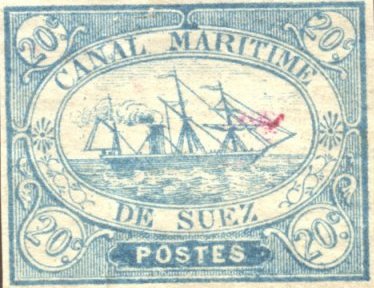 |
The stamps were lithographed in sheets of 12 x 10 by M. Chezaud in Paris. The paper was
watermarked once (LA+-F - the + being a rather fancy Maltese cross), but, because the paper
sheet was large enough to contain several sheets of stamps, most stamps show no sign of the
watermark.
The stamps (which were all imperforate) came in four denominations 1c., 5c., 20c. and 40c.
The basic stamp was the 20c. which was printed from a single stone. The other values were made
from blocks of four of the this stone.
The stamps have all been plated by their constant plate flaws. There are
therefore 120 different types of the 20c. stamp, but only four of each of the other values.
The characteristics of each of the 120 types of the 20c. are described in "The Stamps of the
Suez Canal" by Jean Boulad (Cairo, 1948). |
A 20c. stamp that I have been told is genuine.
(Please ignore the accidental red ink.)
|
|
******CANCELLATIONS******
 Normally manuscript (pen cancels), but, since these were only local stamps,
the covers needed other stamps on them to go any further. These were usually either French
or Egyptian and were usually cancelled either with the French numeral type (a vertical diamond
of dots with numerals in the centre "5105" for Suez" or "5129" for Port Said) or an Egyptian
cds as illustrated (Robson Lowe Encyclopedia Vol.2 (1949). Sometimes
part of the cancel fell upon the Suez Canal stamp but this was accidental as postal employees
would usually take pains to avoid giving any official status to what were really only private
company labels.
Normally manuscript (pen cancels), but, since these were only local stamps,
the covers needed other stamps on them to go any further. These were usually either French
or Egyptian and were usually cancelled either with the French numeral type (a vertical diamond
of dots with numerals in the centre "5105" for Suez" or "5129" for Port Said) or an Egyptian
cds as illustrated (Robson Lowe Encyclopedia Vol.2 (1949). Sometimes
part of the cancel fell upon the Suez Canal stamp but this was accidental as postal employees
would usually take pains to avoid giving any official status to what were really only private
company labels.
******PLATING CHARACTERISTICS******
(This information came from the Barefoot book.)
THE 1c, 5c and 40c stones were all derived from blocks of four of the 20c stone. There are thus
only four types of each of these three values, each type having characteristic plate flaws as
shown below. If your stamp cannot be assigned a type (and is, of course, a 1c, 5c, or 40c),
then it is a forgery.
| TYPE A | TYPE B | TYPE C | TYPE D |
***************************ONE CENT***************************
|
 |
 |
 |
 |
Dot over the 'S' of "SUEZ".
Low dot before the 'C' of
"CANAL". Two dots over
second 'A' of "CANAL" |
Small line after 'E' of
"DE". Spike protruding from the 'L' of "CANAL" |
Spike protruding into 'D'
of "DE". Damaged crossbar in first 'A' of "CANAL" |
High dot before the 'C' of "CANAL".
Broadened centre line of 'E' in "MARITIME"
|
***************************FIVE CENTS***************************
|
 |
 |
 |
 |
| Two lines, in front of and into the 'R' of "MARITIME". Dot on centre line of 'E' of
"MARITIME". |
Break in line going up to aft-mast on ship. |
Dot on downward line of second 'A' and on right-most serif of 'L' in "CANAL". High dot
before 'D' of "DE" |
Diagonal line from right-most serif of 'N' of "CANAL". Dot in horizontal line under 'P'
OF "POSTES". |
***************************FORTY CENTS***************************
|
 |
 |
 |
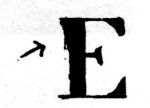 |
| Broken crossbar in 'T' OF "MARITIME". Long 'T' in "POSTES". |
Dot above 'E' of "SUEZ" and between the lines below the 'E' of "MARITIME".
Dot between ropes at front of ship. |
Thickened 'D' in "DE". Broken 'T' in "POSTES". broken line up to aft-mast on ship. |
Thickened vertical in 'E' of "SUEZ". |
******GENUINE FIVE CENT STAMPS******
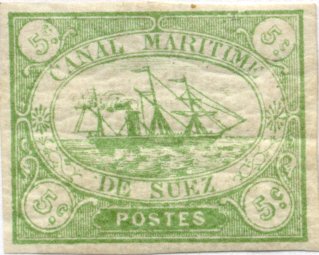 |
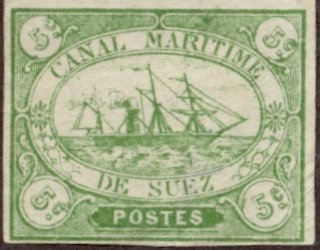 |
This stamp that appears to be genuine. The gum is yellow
and cracked (trust me!) while the stamp itself passes all the usual tests for genuineness
and, furthermore, can be plated as a type 'C' (The dot in front of
"DE" and the distortions in the second "A" and "L" of "CANAL"). |
This stamp also seems to be genuine. There is no gum; otherwise, all tests
are passed; the stamp can be plated as a type 'A' (the two lines in front of and into the
"R" and the dot on the centre line of the "E" of "MARITIME"). |
******THE FORGERIES ******
These stamps are amongst the most heavily forged issues in the world.
There are, basically, two different classes of forgeries.
- The "Reprint Forgeries" are the most dangerous. These were made from the genuine stone of
the 40c stamp that had been taken from the Company archives with new values inserted as
necessary. If you have a 1c or 5c stamp that shows the plating characteristics of the 40c,
then you have one of these (a 20c stamp might just be one that came from a stone used to make
the 40c stamps). Fortunately, these forgeries have the wrong sort of gum (see below).
- All the others. There are many 'brands' of varying quality, and different types of paper
and gum could be used for the same 'brand' of forgery.
******OTHER TESTS FOR GENUINENESS******
The Robson Lowe Encyclopaedia of British Empire Stamps (1949 ed.) briefly lists the following
criteria for GENUINE stamps:
- Area between "DE SUEZ" and "POSTES" has oblique lines crossing the vertical lines.
[This is the first thing to look for!]
- Both flags are single-pointed and outlined only.
- Funnel often solid but shaded with vertical lines.
- No man on deck behind funnel.
- One man at the front end.
- Clouds only light, can be absent in worn impressions.
Jean Boulard (L'OP 61, Jan.1948, p.254) lists these criteria, also for GENUINE stamps:
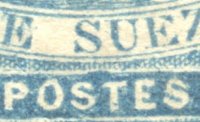
|
The space between the label containing "POSTES" and the lower part of
the oval containing "DE SUEZ" is filled with lines of shading. These
are both vertical and oblique lines.
The last "S" of "POSTES" is almost invariably somewhat flattened at the
left of the bend of the upper loop.
|
 On the ship there is one passenger in the bows, two between the fore and
main mast, and one behind the main mast.
On the ship there is one passenger in the bows, two between the fore and
main mast, and one behind the main mast.
Behind the funnel, just to the right of the point where the lines of the
rigging join the rail, there is a spot of colour which might represent a
passenger.(This might be a contradiction of Robson Lowe #4).
At the very stern of the ship, to the left of the rear mast, there are
two spots of colour.
The funnel of the ship ia always very darkly shaded, usually solid at
the left, whilst the right hand portion is made up of vertical lines of
shading only. The only horizontal line appearing on the funnel is a band
about half a millimetre from the top. Occasionally the funnel is a
solid mass of colour.
|
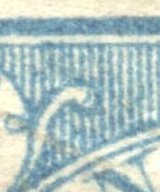 |
The appendage on each side of the upper circles containing the figures
of value are well drawn, and generally clear except for a dot or stroke
which appears in the ball at the extremity.
|
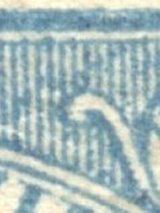
|
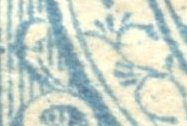 |
Immediately above the floral appendages attached to the lower circles of
value are two comma-like ornaments, the right hand one being unshaded
and smaller than the one on the left.
|
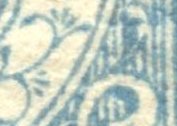
|
CLOUDS: Are usually very lightly shown, but occasionally (on new plates?) quite heavy.
SMOKE: Never touches the left frame line and usually ends about 1.5 mm away, but occasionally
approaches to within 0.5 mm.
GUM: Is almost always cracked. Varies in shade. Forged stamps seldom, if ever,
have cracked gum; if there is any at all, it is smooth and usually white.
INK: Is always matte; never shiny. Colours can vary considerably.
1c. - Black to a rather pale grey.
5c. - From yellowish-green to a full pale green (almost a light emerald).
20c.- From deep indigo to pale dull blue.
40c.- From carmine to dull vermilion.
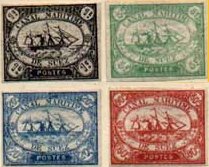 |
This is a set that appeared on eBay recently. It was mounted on a sheet
of paper signed
by an "A. Brun" in 1938 attesting to their genuineness. Whether these were the original
stamps that were attested, I cannot say, but, from what I can see, they look genuine
enough; the colours are brilliant. Genuine stamps look like oil paintings whereas the
reprint forgeries tend to look like watercolours.
|
******A LOOK AT SOME FORGERIES******
THE ONE CENT BLACK
The stamp on the left shows several errors: no crosshatching between "DE SUEZ" and "POSTES",
A passenger in the wrong spot, underneath the line coming down from the aft-mast, but none
in the bows. There is cross-hatching almost all the way down the funnel, lines between stamps
(not present in the originals), incorrectly drawn ornaments below the sunbursts in the border
around the ship. Traces of white, smooth gum on the back. This is a forgery attributed to
Fournier.
The stamp on the right is a much more cunning forgery; the crosshatching above "POSTES" is
present and almost everything else is in order (there is no gum, but this could have been
washed off - a common way of preserving mint stamps in hot, humid climates.) However, there is
no horizontal band near the top of the funnel and, more significantly, the stamp cannot be
plated: it conforms to none of the four types of the 1c shown above. Also, the funnel is too
vertical.
THE TWENTY CENTS BLUE
Here the stamp on the left is neat looking but, if you examine the details, it is only an
approximation of the original.
- There is no crosshatching above "postes".
- The appendage to the upper circles are not separated from the circles, but part of them.
- The figures of value are too small; in the originals they touch the borders.
- The commas above the lower value tablets are joined to the tablets (and are much larger).
- The smoke goes all the way to the edge of the oval.
(I can't help feeling that the forger was trying to tell us what the stamp would have looked
like had it been designed by someone with better taste; a someone such as himself! But I
have to say that his ship looks too much like a toy perched on waves that are just too neat.)
While the stamp on the right might be, in its details, more accurate than the other, it is
such an ugly and coarsely done affair that one glance at it would be enough to decide that
it was a forgery. The extraordinarily unimaginative "cancellation" only confirms this
conclusion.
******LINKS******
Other pages that deal with this issue include:
SUEZ CANAL STAMPS
Dr. Fleming illustrates some SC stamps and asks you to decide on their genuineness. He also
provides a significant amount of useful information.
EGYPT, SUEZ CANAL COMPANY
Illustrations of what would seem to be forgeries, especially the bogus cancellations!
There is some information on quantities printed.
TURKEY
The Barefoot Guide
is offered herein (item #0425) at GBP 3.00.
PHILATELIC LITERATURE.COM
This "Egypt page" offers "Ringström/Tester: Private Ship Letter Stamps of the World. Part 3.
The Suez Canal Company US$80.00"
If you have any comments, questions or advice, you can send them right
NOW or later to:
rjbw@shaw.ca.
Return to A CENTRE FOR STAMP COLLECTORS
A Continuing Project, First Published 1st. of March, 2002.
Latest Revision
on 6th. April 2002


 Normally manuscript (pen cancels), but, since these were only local stamps,
the covers needed other stamps on them to go any further. These were usually either French
or Egyptian and were usually cancelled either with the French numeral type (a vertical diamond
of dots with numerals in the centre "5105" for Suez" or "5129" for Port Said) or an Egyptian
cds as illustrated (Robson Lowe Encyclopedia Vol.2 (1949). Sometimes
part of the cancel fell upon the Suez Canal stamp but this was accidental as postal employees
would usually take pains to avoid giving any official status to what were really only private
company labels.
Normally manuscript (pen cancels), but, since these were only local stamps,
the covers needed other stamps on them to go any further. These were usually either French
or Egyptian and were usually cancelled either with the French numeral type (a vertical diamond
of dots with numerals in the centre "5105" for Suez" or "5129" for Port Said) or an Egyptian
cds as illustrated (Robson Lowe Encyclopedia Vol.2 (1949). Sometimes
part of the cancel fell upon the Suez Canal stamp but this was accidental as postal employees
would usually take pains to avoid giving any official status to what were really only private
company labels.












 On the ship there is one passenger in the bows, two between the fore and
main mast, and one behind the main mast.
On the ship there is one passenger in the bows, two between the fore and
main mast, and one behind the main mast.




